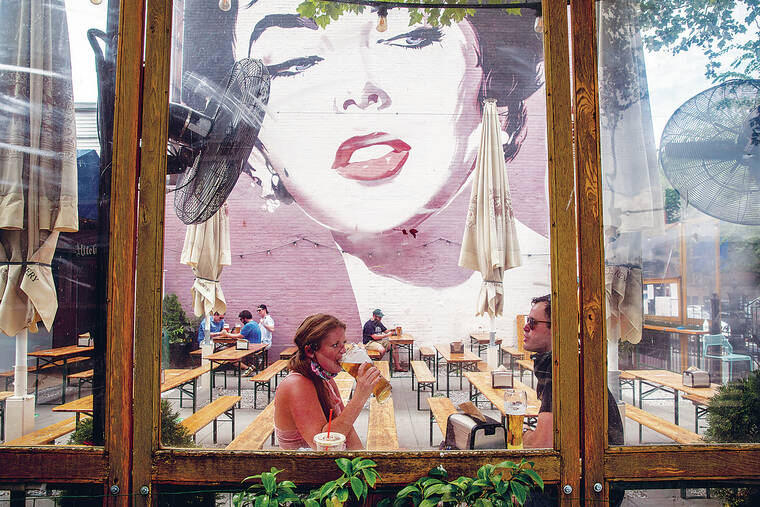Can beer convince Americans to drink recycled wastewater?
Earlier this year, a new beer appeared on the menu at Fox City Brewing Company in Forsyth, Georgia. Opened three years ago in a former ice house an hour south of Atlanta, Fox City serves pale ales, stouts and other microbrews. The new addition, called Revival Lager, stands apart from anything it’s made before — and from nearly every other beer on tap in the U.S. Fox City’s menu calls it a “light, crisp, eco-friendly lager made from highly repurposed and recycled water.” This is a delicate way of saying that it’s made from treated sewage. “We flower up the verbiage a little bit, to make sure people try it,” says Chris Bump, the brewer at Fox City, sitting in the taproom on a Tuesday afternoon in March. When a waitress brings over two pints of Revival, Bump, a 35-year-old Georgia native with tattooed arms, a full beard and floppy baseball cap, raises a toast before we both take a sip. It is, as advertised, a refreshing, easy-drinking beer.
Bump did not wake up one morning and decide to try brewing a beer with recycled wastewater. The idea came to him via the Canadian water technology company H2O Innovation, which operates a sewage treatment plant in Forsyth and wanted a beer to serve at the annual symposium of the WaterReuse Association. Held this year in Atlanta, the event brings together hundreds of utility leaders, engineers and scientists to discuss the state-of-the-art in recycling water. A few hours after I shared a pint with Bump, cans of Revival would be served at a symposium party at the Georgia Aquarium, where self-professed “water nerds” mingled while manta rays and beluga whales swam behind glass walls.
ADVERTISING
Fox City is not the first microbrewery to be enlisted in the cause of “potable reuse,” the industry term for reintroducing treated wastewater into a drinking-water supply. Utilities have spent decades trying to convince U.S. cities and towns that drinking recycled water is safe, but proposals for so-called “toilet-to-tap” systems have stirred up resistance and backlash. In response, advocates are increasingly turning to beer as a go-to strategy for helping consumers overcome the yuck factor. And as more cities find themselves squeezed between growing populations and drought-stressed water supplies — making potable reuse a more attractive, if not inescapable, option — wastewater beers are likely to proliferate in the years ahead. “If you give somebody a glass of water and tell them that it’s been purified from wastewater, more than likely one person out of two will not drink it,” says Guillaume Clairet, chief operating officer at H2O Innovation.
“But if you convert that same water to beer, then all of a sudden nine out of 10 will.” In treatment
The water Bump used to make Revival came from the northwestern edge of Los Angeles, where the Las Virgenes Municipal Water District recently opened a small demo facility as a showcase for the public to learn about potable reuse. Las Virgenes depends entirely on water from the California State Water Project, a 700-mile system of canals, dams and pumps that transports fresh water from the northern part of the state.
After that water passes through toilets and drains in the district, it goes to a traditional waste treatment plant; from there, it’s either discharged into a local creek (and eventually into the Pacific Ocean) or sent through specially designated purple pipes to irrigate parks and golf courses. Three years ago, Las Virgenes began piping a small fraction of the plant’s outflow — about 1 million gallons a day — into the demo facility, where it is put through the additional steps of ultrafiltration (UF), reverse osmosis (RO) and an ultraviolet-advanced oxidation process (UV AOP) to be brought up to state’s standards for recycled drinking water.
Each step in this alphabet soup of water tech removes increasingly small contaminants, from bacteria to viruses to salts and hormones. “The reuse industry is about belts and suspenders,” says Clairet at H2O Innovation, which makes the UF and RO equipment used in Las Virgenes. When the WaterReuse Association suggested brewing a beer for its symposium, Clairet, who sits on the planning committee, took on the job of figuring out how to do it. He had hoped to get the water from the onsite treatment system at a hospital in Atlanta, which uses H2O equipment to recycle wastewater for heating and cooling, but Georgia state law lacked a framework to allow it to be used for drinking.
So once Fox City was on board, Clairet called his contacts at Las Virgenes, who agreed to supply the water. In January, Las Virgenes put a half dozen 55-gallon drums of purified water on a truck to Forsyth, where Bump pumped it into his hot liquor tank — the first step in the beer-making process — and got to work.


